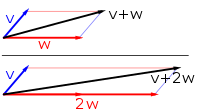
Photo from wikipedia
A complete understanding of how an orientation distribution contributes to a cryo-EM reconstruction remains lacking. It is necessary to begin critically assessing the set of views to gain an understanding… Click to show full abstract
A complete understanding of how an orientation distribution contributes to a cryo-EM reconstruction remains lacking. It is necessary to begin critically assessing the set of views to gain an understanding of its effect on experimental reconstructions. Toward that end, we recently suggested that the type of orientation distribution may alter resolution measures in a systematic manner. We introduced the sampling compensation factor (SCF), which incorporates how the collection geometry might change the spectral signal-to-noise ratio (SSNR), irrespective of the other experimental aspects. We show here that knowledge of the sampling restricted to spherical surfaces of sufficiently large radii in Fourier space is equivalent to knowledge of the set of projection views. Moreover, the SCF geometrical factor may be calculated from one such surface. To aid cryo-EM researchers, we developed a graphical user interface (GUI) tool that evaluates experimental orientation distributions. The GUI returns plots of projection directions, sampling constrained to the surface of a sphere, the SCF value, the fraction of the empty region of Fourier space, and a histogram of the sampling values over the points on a sphere. Finally, a fixed tilt angle may be incorporated to determine how tilting the grid during collection may improve the distribution of views and Fourier space sampling. We advocate this simple conception of sampling and the use of such tools as a complement to the distribution of views to capture the different aspects of the effect of projection directions on cryo-EM reconstructions.
Journal Title: Progress in biophysics and molecular biology
Year Published: 2020
Link to full text (if available)
Share on Social Media: Sign Up to like & get
recommendations!